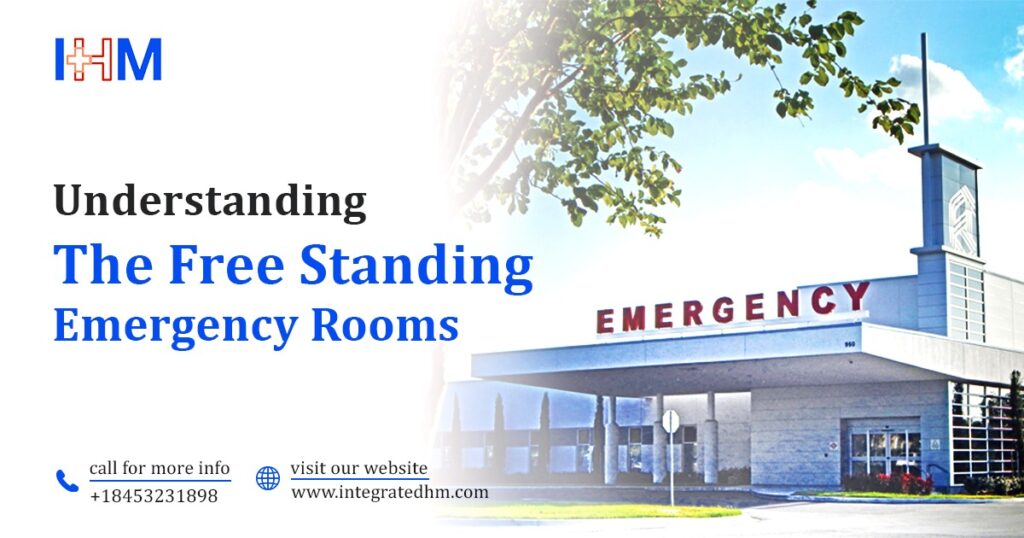The healthcare industry is always changing, and one noteworthy trend that has drawn notice is the rise of Freestanding Emergency Rooms (FSERs). These facilities, which are essential to the provision of timely emergency treatment, have come to be discussed often in relation to healthcare. Healthcare professionals and patients should both understand FSERs since they give an alternative to typical hospital-based emergency treatment.
What is a Free standing Emergency Department?
Free-Standing Emergency Rooms (FSERs) are stand-alone medical establishments created to offer emergency treatment apart from the conventional hospital environment. Their purpose is to provide quick and easy access to emergency care for a wide variety of medical issues, which is why they are placed strategically across towns. The independence of FSERs from hospital-based emergency departments allows for greater flexibility in the distribution of resources and the provision of services.
Understanding the Freestanding Emergency Rooms
- Recognizing the unique features of free-standing emergency rooms is essential to understanding them. Because these facilities run separately from hospitals, they have a special degree of autonomy when it comes to managing resources and providing emergency services that are tailored to the requirements of the community. Additionally, their thoughtful location within communities greatly improves emergency care accessibility, bridging critical gaps, particularly in regions where hospital-based emergency treatments may not be readily available. The fundamental characteristics of free-standing emergency rooms are their autonomy and accessibility, which emphasizes their critical role in providing timely and individualized emergency treatment.
Advantages of Free-Standing Emergency Rooms:
- Free-Standing Emergency Rooms (FSERs) place a high priority on providing prompt, effective emergency care, with a particular focus on quick access to healthcare. FSERs seek to improve overall patient outcomes by drastically cutting wait times and guaranteeing timely answers to urgent medical needs. Moreover, these establishments embrace a community-focused methodology by deliberately situating themselves inside communities. By offering easily accessible emergency care alternatives, this strategic location addresses the immediate medical requirements of the local population and enhances community well-being. It is crucial in generating improved community health outcomes.
Challenges and Considerations:
- Free-standing emergency rooms (FSERs) present a dilemma with regard to regulatory compliance and financial issues. Even if these clinics are more convenient and provide faster care than typical emergency rooms, there are still worries about possible higher costs. Such disparities in cost present problems for insurance reimbursements and patient affordability; therefore, healthcare planning must take this into account carefully. Furthermore, maintaining compliance with strict regulatory criteria and compliance standards is essential to the smooth functioning of FSERs. Maintaining the legality and efficacy of these autonomous emergency care clinics requires navigating licensing processes, staffing requirements, and other legal restrictions.
IHM’s Role in Supporting Free-Standing Emergency Rooms:
- The integrated healthcare management (IHM) is an essential partner that helps Free-Standing Emergency Rooms (FSERs) succeed operationally. One of the main factors contributing to FSERs’ financial performance is IHM’s proficiency in revenue cycle management, or RCM. IHM guarantees the effective administration of financial issues essential to these autonomous emergency care facilities’ survival by supervising billing processes, controlling collections, and optimizing income sources. Furthermore, as correct coding is essential to receiving healthcare payments, FSERs benefit greatly from IHM’s expert coding services. IHM helps FSERs manage complex coding specifications, make sure compliance guidelines are followed, and optimize reimbursements to increase profits. Moreover, IHM’s commitment to operational effectiveness is in perfect harmony with the requirement for FSER procedures to be optimized. By optimizing internal processes, IHM contributes significantly to enhancing the overall delivery of patient care within these independent emergency care facilities.
Conclusion:
To sum up, Freestanding Emergency Rooms (FSERs) offer a cutting-edge method of providing emergency care by providing prompt and easily accessible services in local areas. This essay has offered a thorough examination of FSERs, emphasizing their definition, goal, benefits, drawbacks, and considerations. With its proficiency in coding, Revenue Cycle Management, and operational efficiency, IHM is a valuable partner for medical professionals and healthcare providers starting or running free-standing emergency rooms.
IHM’s dedication to education and openness is demonstrated by its efforts to comprehend and promote new developments, such as freestanding emergency rooms, even as it continues to support independent medical practices. This proactive involvement makes a substantial contribution to the continuing conversation that shapes the changing face of healthcare delivery.
FAQ’S
1. What distinguishes Free-Standing Emergency Rooms (FSERs) from traditional hospital-based emergency departments?
FSERs are standalone medical facilities designed to provide emergency care independently of traditional hospital settings. They prioritize quick access to healthcare and operate with a higher degree of autonomy.
2. How do Free-Standing Emergency Rooms (FSERs) benefit the community in terms of healthcare accessibility?
FSERs strategically position themselves within communities, significantly reducing wait times and ensuring prompt attention to urgent medical needs. This enhances accessibility and addresses local medical requirements, contributing to improved community health outcomes.
3. What challenges do Free-Standing Emergency Rooms (FSERs) face, especially in terms of regulatory compliance and financial considerations?
Despite their convenience, concerns exist about potentially higher costs associated with FSERs. Navigating regulatory compliance, insurance reimbursements, and patient affordability pose challenges that require careful consideration in healthcare planning.

